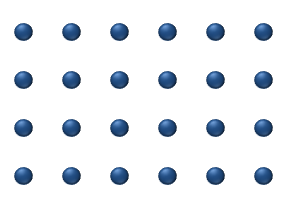Diffusion Formula
Diffusion
It refers to the tendency of a substance from an area of high concentration to a low concentration area. In addition, it happens in gases and liquid as their particles are free to move randomly from one place to another. It is an important process in living things and due to these substances move in and out of a cell. Learn the diffusion formula here.

Fick’s law
Adolf Fick developed this law in the 19th century, Fick’s law is the simplest explanation of diffusion:
- He explained that molar flux due to diffusion is proportional to the concentration gradient.
- Also, the rate of change of absorption is a point in space that is proportional to the second derivative of concentration with space.
First law of Diffusion
In the modern mathematical form, the Fick’s first law of diffusion is:
Here for species
Also, from the continuity equation for mass:
Besides, we can derive Fick’s second law directly:
This assumes that
The second law of Diffusion
The second law of Fick is a linear equation on which the dependent variable being the concentration of the chemical species under consideration. Also, the diffusion of each chemical species occurs independently. Moreover, these properties make it easy to describe mass transport systems by Fick’s second law to simulate numerically.
In addition, it is a good idea, to begin with, modeling diffusion as with the assumption that all diffusion coefficients are equal and independent of temperature, pressure, etc.
Also, this simplification confirms that the linearity of the mass transport equations in the modeled domain and often allows simpler correlations to know analytical limits. Besides, we can relax this behavior of the system with all equal diffusion coefficients is well implicit.
In addition, dimensional analysis of Fick’s second law discloses that in diffusive processes. There is a fundamental relation between the pass by time and the square of the length over which diffusion takes place. Also, considerating this relation is very vital for an accurate numerical simulation of diffusion.
Multi-component Diffusion
When rigorous solutions or gas combinations where more than one chemical type is present in substantial mass fractions, it is no longer the case that the diffusion coefficient can treat as a constant or composition-independent.
Also, the interactivity of the different species’ molecules with each other is too widespread for a physical description that ignores these inter-molecular dependencies. Hence, the diffusion coefficient becomes a tensor and the equation for diffusion reforms to relate the mass flux of one chemical species to the concentration upgrades of all chemical species present.
Also, it formulates the necessary equations as the Maxwell-Stefan description of diffusion; Often we apply them to describe gas mixtures, such as syngas in a reactor or the mix of oxygen, nitrogen, and water in a fuel cell cathode.
Solved Example for You
Question: Give the formula of Maxwell-Stefan diffusion?
Solution: The formula of Maxwell-Stefan diffusion is:
Besides, They are related to the concentration and each other as: